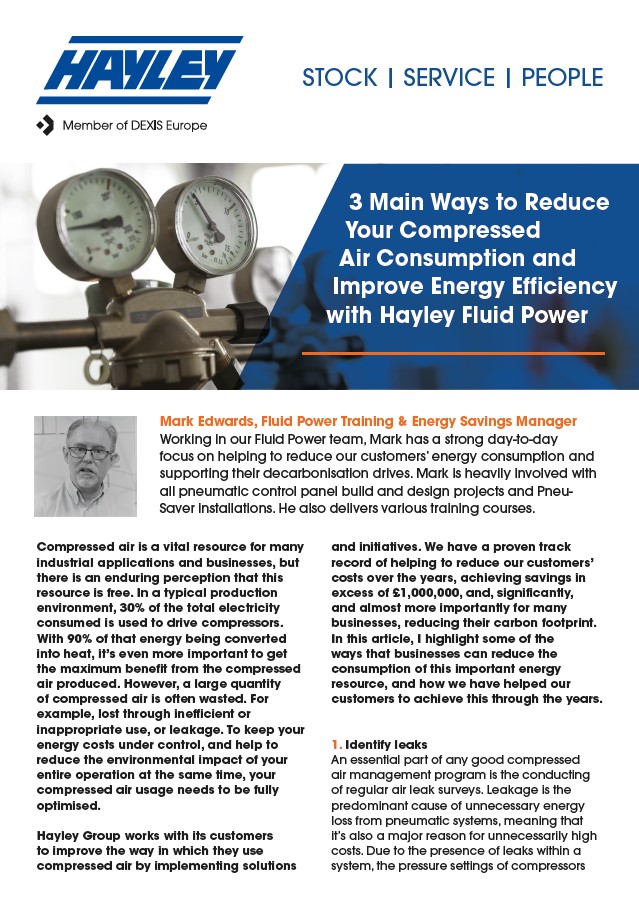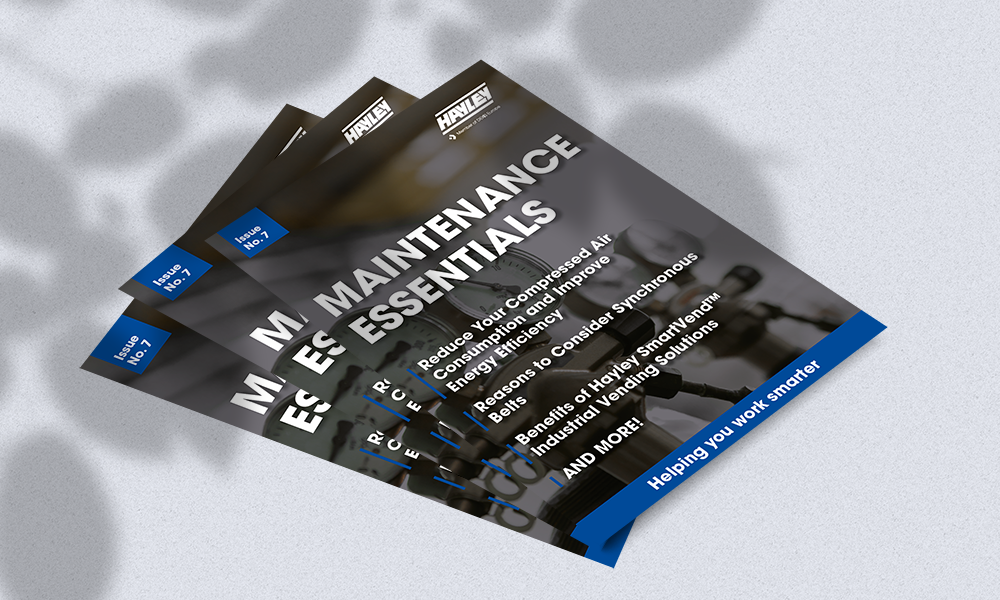Mark Edwards, Fluid Power Training & Energy Savings Manager
Working in our Fluid Power team, Mark has a strong day-to-day focus on helping to reduce our customers’ energy consumption and supporting their decarbonisation drives. Mark is heavily involved with all pneumatic control panel build and design projects and Pneu-Saver installations. He also delivers various training courses.
Compressed air is a vital resource for many industrial applications and businesses, but there is an enduring perception that this resource is free. In a typical production environment, 30% of the total electricity consumed is used to drive compressors. With 90% of that energy being converted into heat, it’s even more important to get the maximum benefit from the compressed air produced. However, a large quantity of compressed air is often wasted. For example, lost through inefficient or inappropriate use, or leakage. To keep your energy costs under control, and help to reduce the environmental impact of your entire operation at the same time, your compressed air usage needs to be fully optimised.
Hayley Group works with its customers to improve the way in which they use compressed air by implementing solutions and initiatives. We have a proven track record of helping to reduce our customers’ costs over the years, achieving savings in excess of £1,000,000, and, significantly, and almost more importantly for many businesses, reducing their carbon footprint.
In this article, I highlight some of the ways that businesses can reduce the consumption of this important energy resource, and how we have helped our customers to achieve this through the years.
1. Identify leaks
An essential part of any good compressed air management program is the conducting of regular air leak surveys. Leakage is the predominant cause of unnecessary energy loss from pneumatic systems, meaning that it’s also a major reason for unnecessarily high costs. Due to the presence of leaks within a system, the pressure settings of compressors are often increased to compensate for the energy lost, to maintain production levels. This is not a viable solution to a leakage problem, as a leak happening at a higher pressure will simply cost more per minute.
Hayley Group’s dedicated Fluid Power division are able to offer full-scale air leak solutions, through our trained ultrasonic air leak detection team. Team members are deployed to customer sites, armed with years of experience and the latest in detection technology, to locate and give accurate measurements of any leaks present. With up to 80% of air leaks not being audible to the human ear, this technology is vital to their detection. Each leak is tagged, photographed, and costed, with the results provided to the customer upon completion. The final report also includes all recommendations and their costings, along with their compelling payback periods. This transparency enables customers to easily recognise the savings potential.
In one particular year, thirty-one air leak surveys were completed by air-leak team. The total value of leaks reported was in excess of £240k, with the total cost of parts to rectify leakage around just £13k. The average payback period was found to be only 1.6 months!
2. Audit applications/inspect distribution
Compressed air is used as an energy resource across a diverse range of applications, but even when it is used in a relatively standard system, there are many improvements that can be made to reduce consumption. Often these have little or no cost, and are easily changed. For instance, if the pressure supplied to a machine could be turned-down by just one bar, the possible saving could be in the region of 7%. Operating times for compressors, a major drain on electricity (often representing almost a third of a facility’s total consumption), is also auditable. Savings can sometimes be easily secured by simply not operating compressors for more hours than absolutely necessary, consider shift patterns and the requirement for evening or weekend running times here.
By also reviewing piping infrastructure and the effectiveness of filtration within the system, the consumption of compressed air can be further reduced. Your piping should transfer compressed air at an optimal flow and pressure to the point-of-use, but this is often not the case. Pressure drops can occur due to pipes being too narrow or too long, and these drops can be reduced by up to 50% by increasing a 2” pipe to a 3” pipe, and also by around 20-40% by shortening the distance the air has to travel. Clogged filters can cause pressure drops in the system, and should be changed systematically to avoid this and to also uphold the quality of the compressed air being used, preventing any possible contamination.
Hayley Fluid Power often conduct a general optimisation survey in conjunction with any leak detection program, as we recognise that inspecting pneumatic applications and usage provides a more comprehensive overview than simply identifying leaks. As a result, it provides our customers with even more opportunities to reduce their compressed air consumption and their costs.
3. Reclaim lost air
At Hayley Fluid Power, we take our client’s energy consumption incredibly seriously. That’s why we work with our network of market-leading supply partners to promote and implement the latest product developments and energy efficient technologies where they are most appropriate. Our commitment to helping our customers in energy and cost-savings has also inspired us to create our own patented Pneu-Saver and Pump-Saver products.
The Hayley Pneu-Saver is an innovative compressed air reclamation device exclusive to Hayley Group. It is a completely unique solution which, when fitted to double-acting pneumatic cylinders, captures and recycles the compressed air that would normally be exhausted and wasted. Wherever it has been implemented, clients have been impressed at just how much of a cost-saving can be made with the device, with consumption being reduced by a guaranteed minimum of 45%. The payback period on the device is consistently under twelve months, making it a wise investment for those using compressed air.
Conclusion
There are many ways that users of compressed air can begin to enjoy significant cost-savings and energy efficiency improvements, by reducing their consumption and recovering what normally would have been wasted. Hayley Group’s fluid power experts are on-hand to help businesses to realise the often-small changes that can be made to their compressed air systems in order to bring costs down and provide a welcome boost to environmental sustainability credentials.
Speak to a member of your local Hayley Group branch to start your energy-saving journey today.




